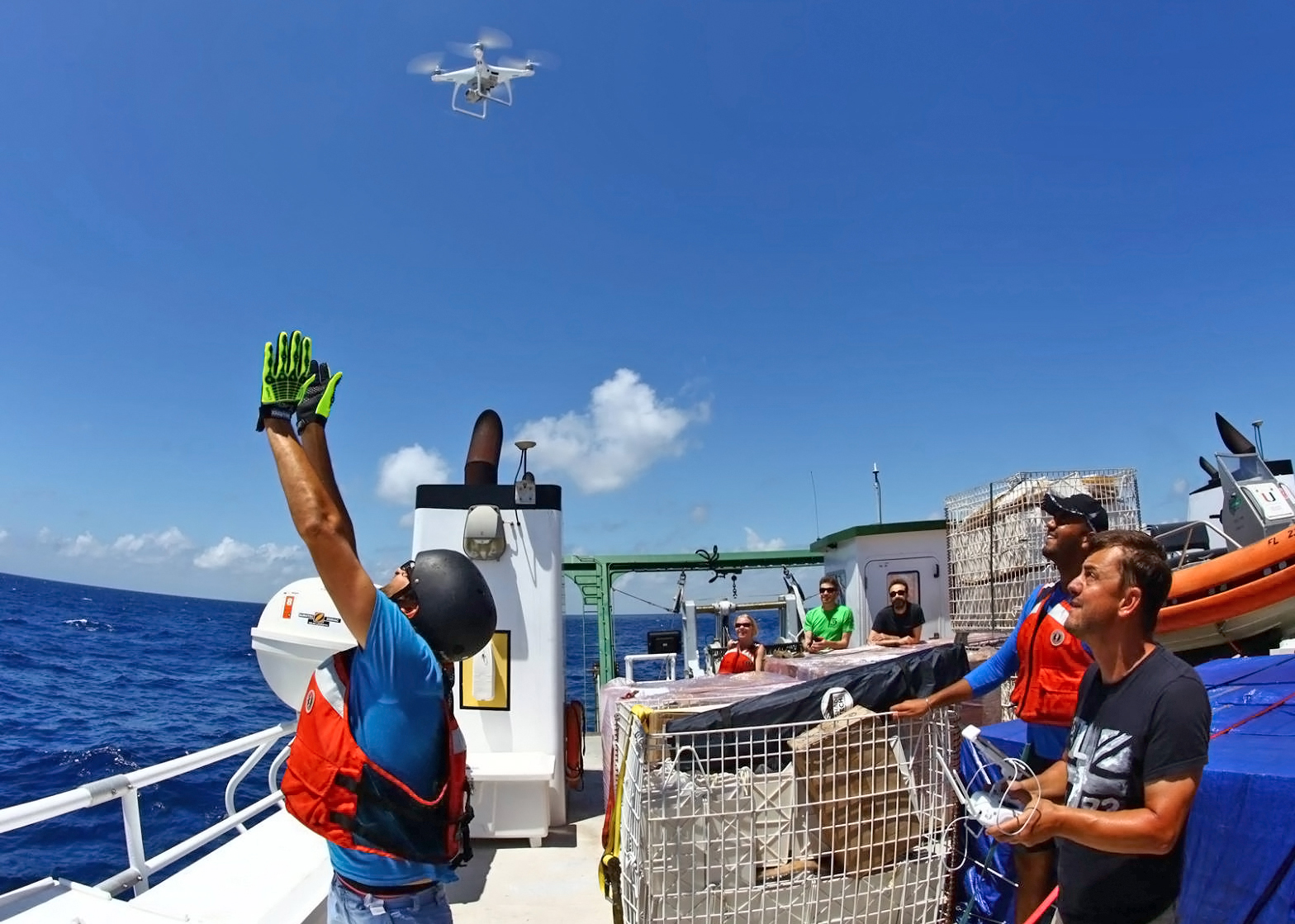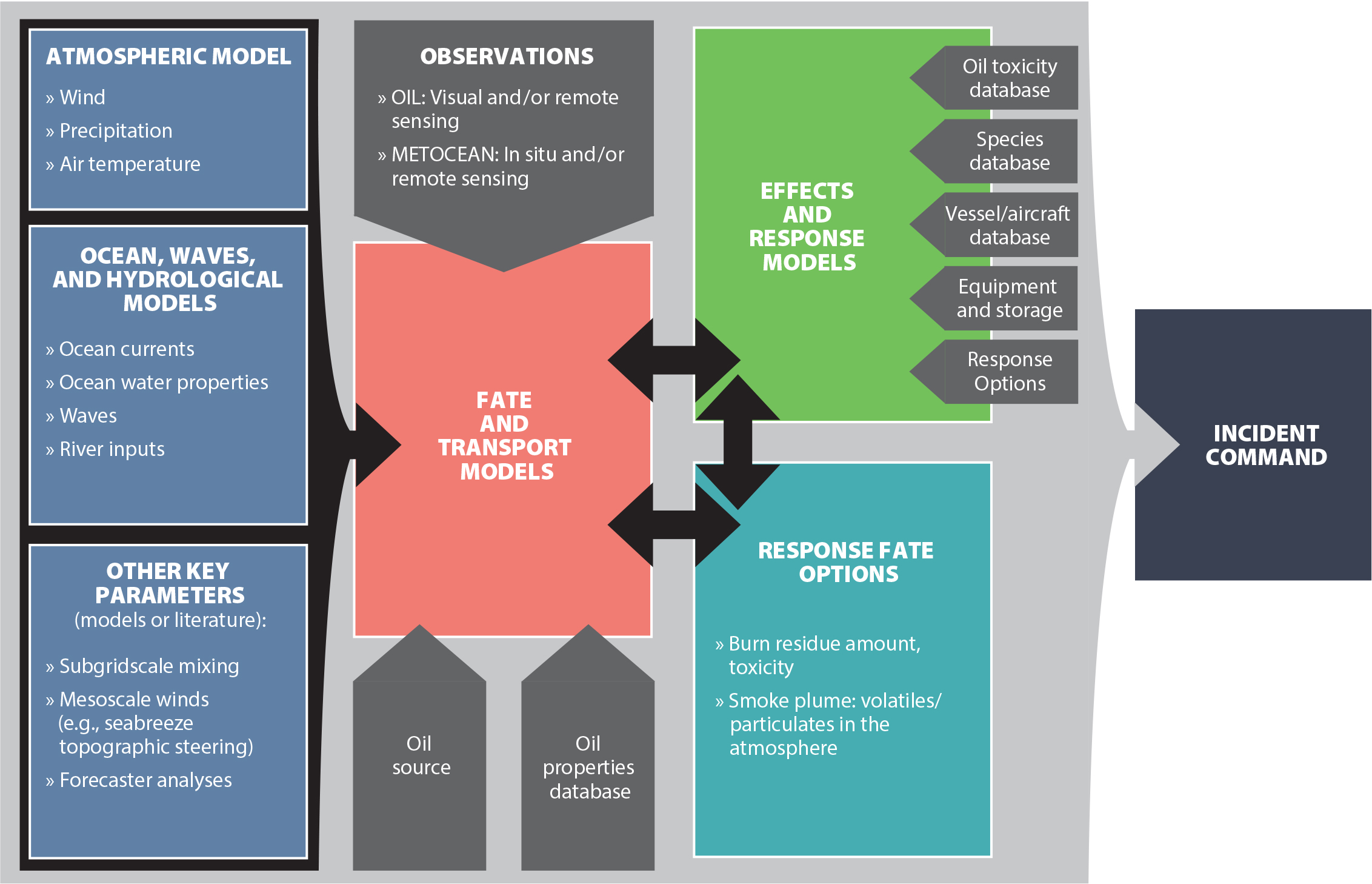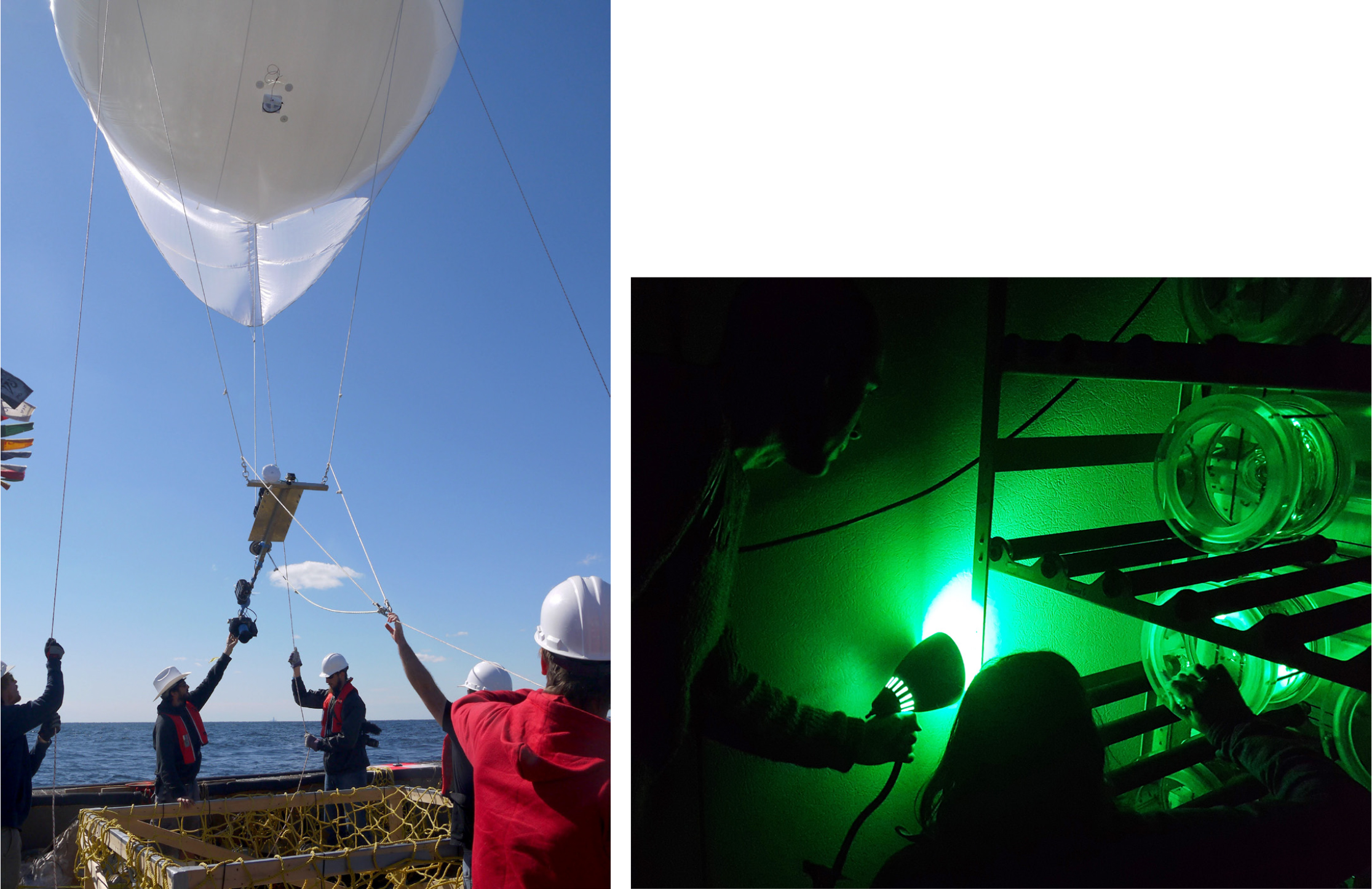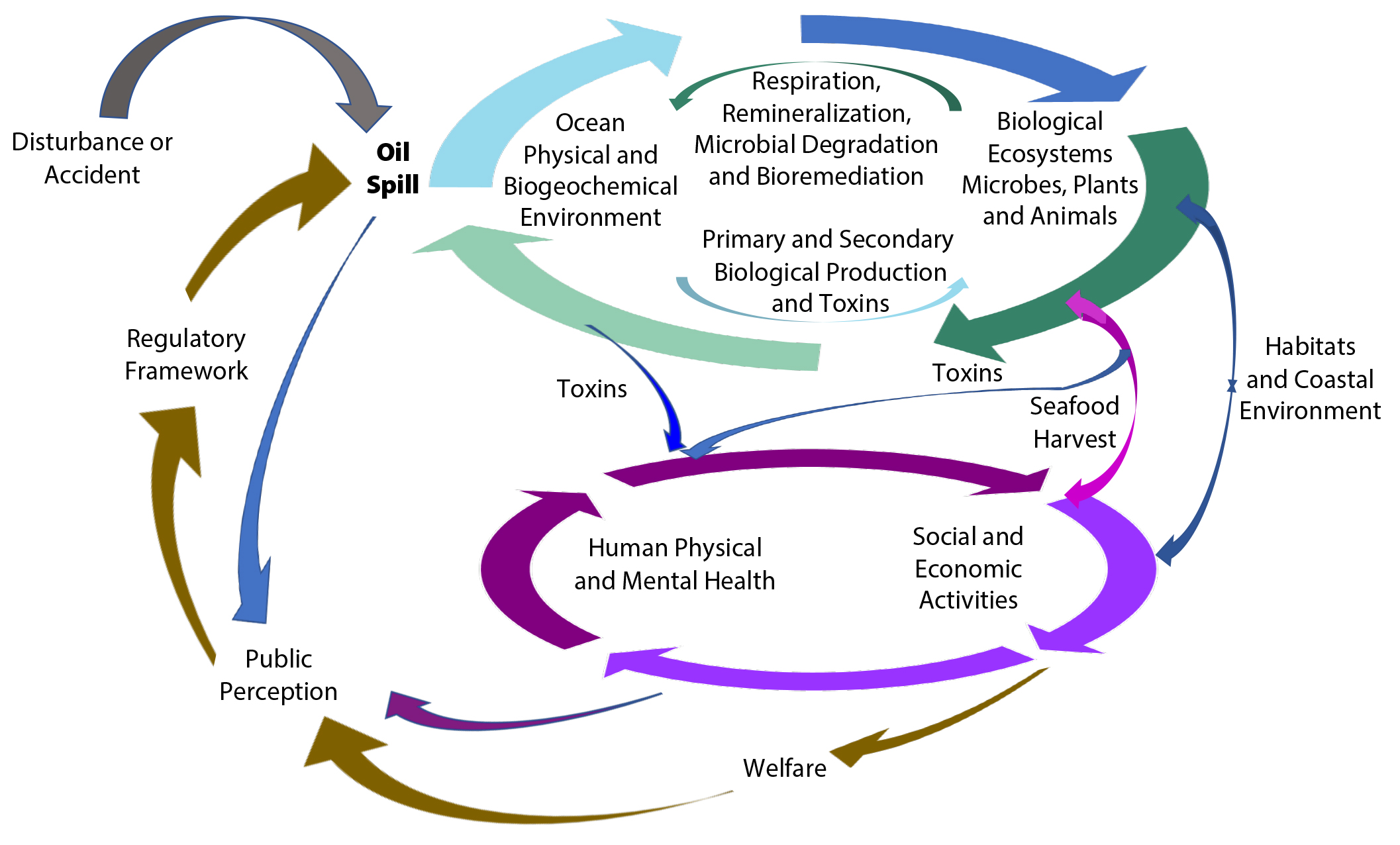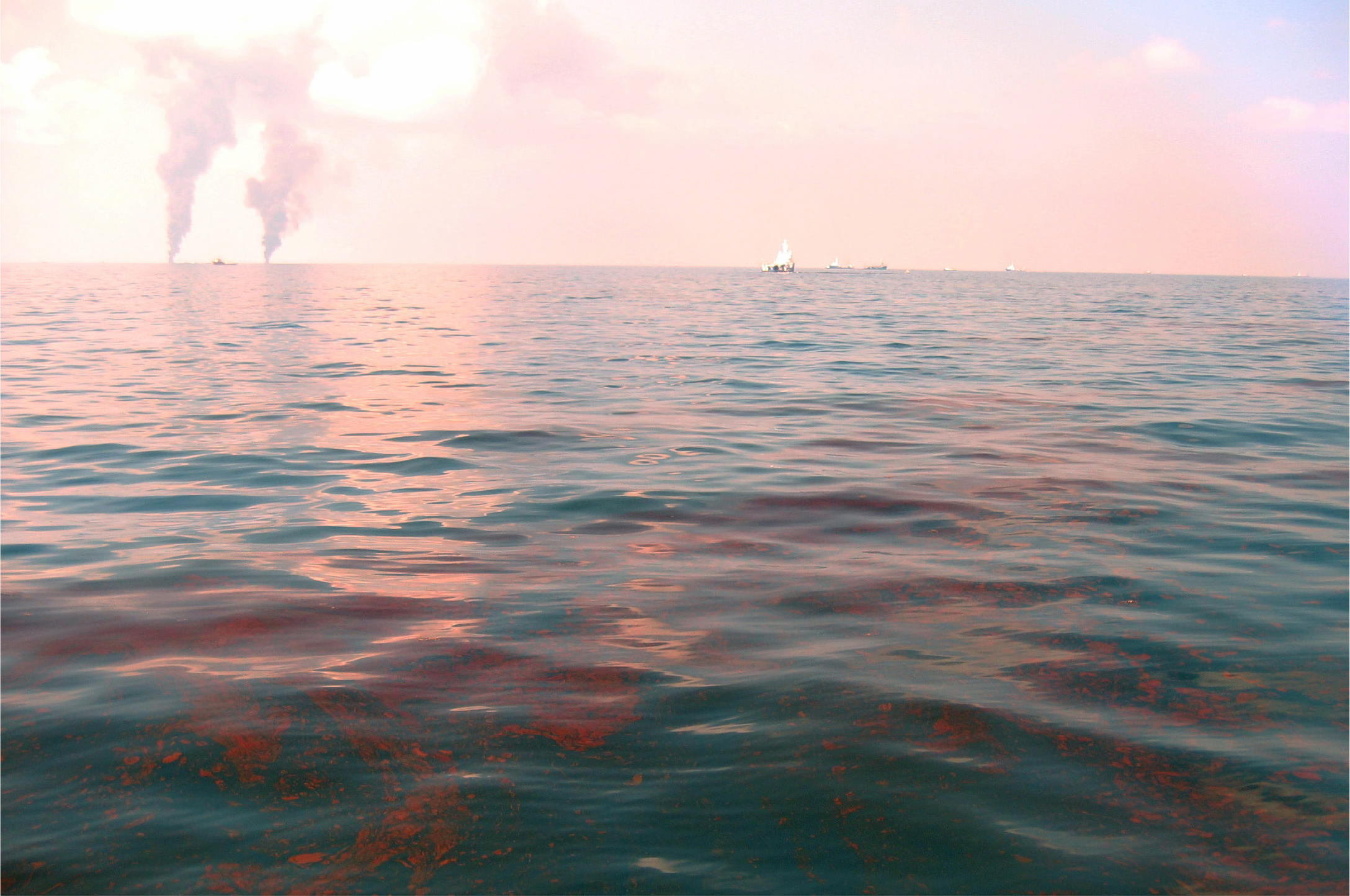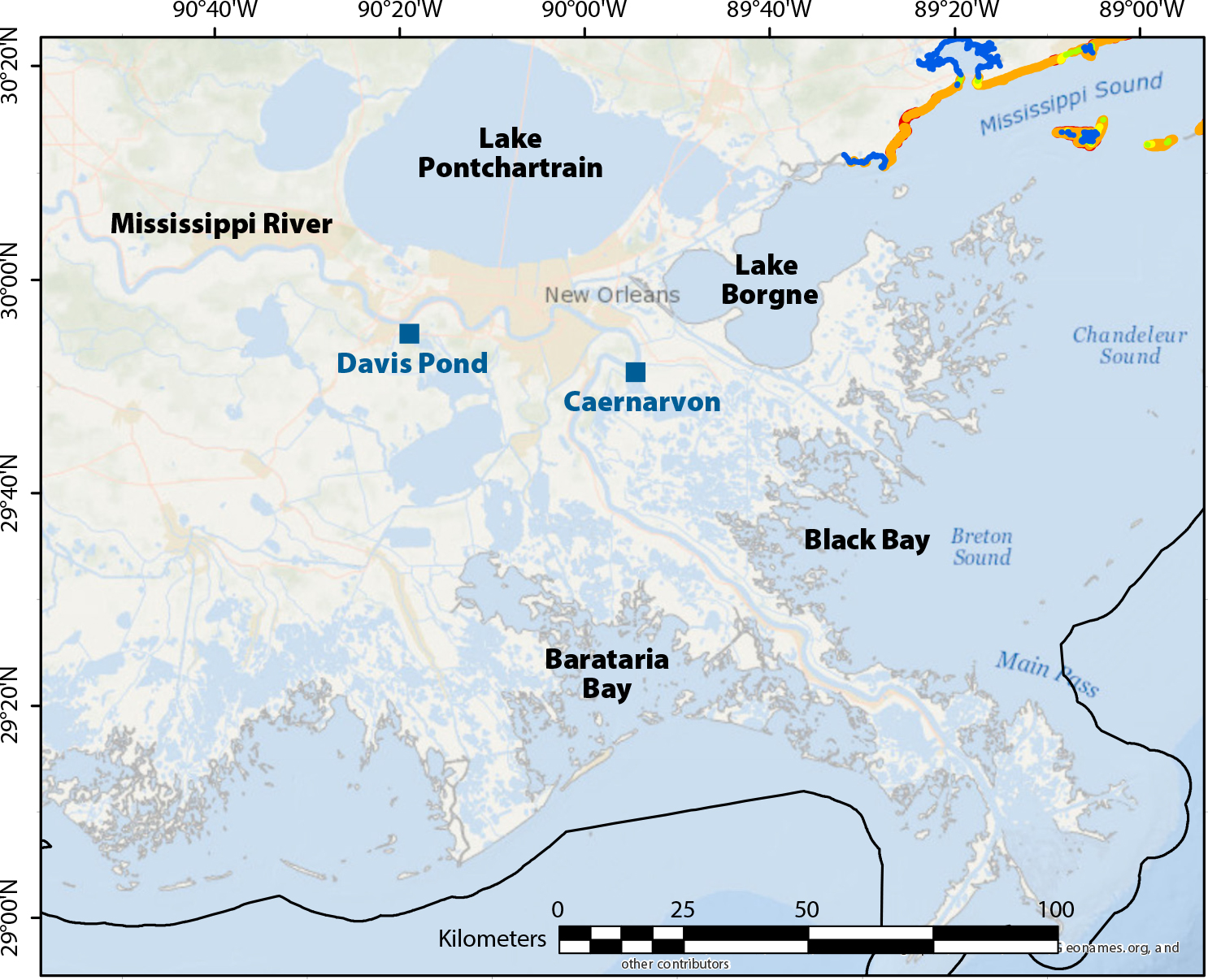Able, K.W., P.C. Lopez-Duarte, F.J. Fodrie, O.P. Jensen, C.W. Martin, B.J. Roberts, J. Valenti, K. O’Connor, and S.C. Halbert. 2015. Fish assemblages in Louisiana salt marshes: Effects of the Macondo oil spill. Estuaries and Coasts 38:1,385–1,398, https://doi.org/10.1007/s12237-014-9890-6.
Abramson, D.M., L.M. Grattan, B. Mayer, C.E. Colten, F.A. Arosemena, A. Bedimo-Rung, and M. Lichtveld. 2015. The Resilience Activation Framework: A conceptual model of how access to social resources promotes adaptation and rapid recovery in post-disaster settings. The Journal of Behavioral Health Services & Research 42:42, https://doi.org/10.1007/s11414-014-9410-2.
Ainsworth, C.H., M.J. Schirripa, and H. Morzaria-Luna, eds. 2015. An Atlantis Ecosystem Model of the Gulf of Mexico: Supporting Integrated Ecosystem Assessment. NOAA Technical Memorandum NMFS-SEFSC-676, 149 pp., https://doi.org/10.7289/V5x63JVH.
Ainsworth, C.H., C.B. Paris, N. Perlin,L.N. Dornberger, W.F. Patterson III, E. Chancellor, S. Murawski, D. Hollander, K. Daly, I.C. Romero, and others. 2018. Impacts of the Deepwater Horizon oil spill evaluated using an end-to-end ecosystem model. PLoS ONE 13(1):e0190840, https://doi.org/10.1371/journal.pone.0190840.
Allard, R., E. Rogers, P. Martin, T. Jensen, P. Chu, T. Campbell, J. Dykes, T. Smith, J. Choi, and U. Gravois. 2014. The US Navy coupled ocean-wave prediction system. Oceanography 27(3):92–103, https://doi.org/10.5670/oceanog.2014.71.
Androulidakis, Y.S., and V.H. Kourafalou. 2013. On the processes that influence the transport and fate of Mississippi waters under flooding outflow conditions. Ocean Dynamics 63(2–3):143–164, https://doi.org/10.1007/s10236-012-0587-8.
Androulidakis, Y.S., V.H. Kourafalou, and R. Schiller. 2015. Process studies on the Mississippi River plume: Impact of topography, wind and discharge conditions. Continental Shelf Research (107)33–49, https://doi.org/10.1016/j.csr.2015.07.014.
Androulidakis, Y.S., V. Kourafalou, T.M. Özgökmen, O. Garcia-Pineda, B. Lund, M.L. Hénaff, C. Hu, B.K. Haus, G. Novelli, C. Guigand, and others. 2018. Influence of river-induced fronts on hydrocarbon transport: A multiplatform observational study. Journal of Geophysical Research: Oceans 123(5):3,259–3,285, https://doi.org/10.1029/2017JC013514.
Androulidakis, Y.S., V.H. Kourafalou, M. Le Hénaff, H. Kang, T. Sutton, S. Chen, C. Hu, and N. Ntaganou. 2019. Offshore spreading of Mississippi waters: Pathways and vertical structure under eddy influence. Journal of Geophysical Research: Oceans 124(8):5,952–5,978, https://doi.org/10.1029/2018JC014661.
Barkan, R., J.C. McWilliams, A.F. Shchepetkin, M.J. Molemaker, L. Renault, A. Bracco, and J. Choi. 2017. Submesoscale dynamics in the northern Gulf of Mexico: Part I. Regional and seasonal characterization and the role of river outflow. Journal of Physical Oceanography 47(9):2,325–2,346, https://doi.org/10.1175/JPO-D-17-0035.1.
Barker, C.H., V.H. Kourafalou, C.J. Beegle-Krause, M. Boufadel, M.A. Bourassa, S.G. Buschang, Y. Androulidakis, E.P. Chassignet, K.-F. Dagestad, D.G. Danmeier, and others. 2020. Progress in operational modeling in support of oil spill response. Journal of Marine Science and Engineering 8(9):668, https://doi.org/10.3390/jmse8090668.
Barth, A., A. Alvera-Azcárate, and R.H. Weisberg. 2008. A nested model study of the Loop Current generated variability and its impact on the West Florida Shelf. Journal of Geophysical Research: Oceans 113(C5), https://doi.org/10.1029/2007JC004492.
Beegle-Krausse, C.J. 2001. General NOAA Oil Modeling Environment (GNOME): A new spill trajectory model. International Oil Spill Conference Proceedings 2001(2):865–871, https://doi.org/10.7901/2169-3358-2001-2-865
Berenshtein, I., S. O’Farrell, N. Perlin, J.N. Sanchirico, S.A. Murawski, L. Perruso, and C.B. Paris. 2019. Predicting the impact of future oil-spill closures on fishery-dependent communities—A spatially explicit approach. ICES Journal of Marine Science 76(7):2,276–2,285, https://doi.org/10.1093/icesjms/fsz138.
Berenshtein, I., N. Perlin, C. Ainsworth, J. Ortega-Ortiz, A. Vaz, and C. Paris. 2020a. Comparison of the spatial extent, impacts to shorelines and ecosystem, and 4-dimensional characteristics of simulated oil spills. Pp. 340–354 in Scenarios and Responses to Future Deep Oil Spills: Fighting the Next War. S.A. Murawski, C.H. Ainsworth, S. Gilbert, D.J. Hollander, C.B. Paris, M. Schlüter, and D.L. Wetzel, eds, Springer, https://doi.org/10.1007/978-3-030-12963-7_20.
Berenshtein, I., C. Paris, N. Perlin, M. Alloy, S. Joye, and S. Murawski. 2020b. Invisible oil beyond the Deepwater Horizon satellite footprint. Science Advances 6(7):eaaw8863, https://doi.org/10.1126/sciadv.aaw8863.
Black, J.C., J.N. Welday, B. Buckley, A. Ferguson, P.L. Gurian, K.D. Mena, L. Yang, E. McCandlish, and H.M. Solo-Gabriele. 2016. Risk assessment for children exposed to beach sands impacted by oil spill chemicals. International Journal of Environmental Research and Public Health 13(9):853, https://doi.org/10.3390/ijerph13090853.
Bock, M., H. Robinson, R. Wenning, D. French-McCay, J. Rowe, and A.H. Walker. 2018. Comparative risk assessment of spill response options for a deepwater oil well blowout: Part II. Relative risk methodology. Marine Pollution Bulletin 133:984–1,000, https://doi.org/10.1016/j.marpolbul.2018.05.032.
Brakstad, O.G., T. Nordtug, and M. Throne-Holst. 2015. Biodegradation of dispersed Macondo oil in seawater at low temperature and different oil droplet sizes. Marine Pollution Bulletin 93:144–152, https://doi.org/10.1016/j.marpolbul.2015.02.006.
Brakstad, O.G., I.K. Almas, and D.F. Krause. 2017. Biotransformation of natural gas and oil compounds associated with marine oil discharges. Chemosphere 182:555–558, https://doi.org/10.1016/j.chemosphere.2017.05.046.
Brakstad, O.G., I.K. Almas, D.F. Krause, and C.J. Beegle-Krause. 2020. Biotransformation of natural gas and oil in oxygen-reduced seawater. Chemosphere 182:555–558, https://doi.org/10.1016/j.chemosphere.2017.05.046.
Brassington, G. 2017. Forecast errors, goodness, and verification in ocean forecasting. Journal of Marine Research 75:403–433, https://doi.org/10.1357/002224017821836851.
Brennan, C., M. Ashley, and O. Molloy. 2019. A system dynamics approach to increasing ocean literacy. Frontiers in Marine Science 6:360, https://doi.org/10.3389/fmars.2019.00360.
Brooks, G.R., R.A. Larson, P.T. Schwing, I. Romero, C. Moore, G.-J. Reichart, T.J. Jilbert, J.P. Chanton, D.W. Hastings, W.A. Overholt, and others. 2015. Sedimentation pulse in the NE Gulf of Mexico following the 2010 DWH blowout. PLoS ONE 10:e0132341, https://doi.org/10.1371/journal.pone.0132341.
Camilli, R., C.M. Reddy, D.R. Yoerger, B.A.S. Van Mooy, M.V. Jakuba, J.C. Kinsey, C.P. McIntyre, S.P. Sylva, and J.V. Maloney. 2010. Tracking hydrocarbon plume transport and biodegradation at Deepwater Horizon. Science 330(6001):201–204, https://doi.org/10.1126/science.1195223.
Capet, X., J.C. McWilliams, M.J. Molemaker, and A.F. Shchepetkin. 2008. Mesoscale to sub-mesoscale transition in the California Current System: Part I. Flow structure, eddy flux, and observational tests. Journal of Physical Oceanography 38:29–43, https://doi.org/10.1175/2007JPO3671.1.
Carrier, M.J., H.E. Ngodock, P. Muscarella, and S. Smith. 2016. Impact of assimilating surface velocity observations on the model sea surface height using the NCOM-4DVAR. Monthly Weather Review 144:1,051–1,068, https://doi.org/10.1175/MWR-D-14-00285.1.
Chassignet, E.P., H.E. Hurlburt, O.M. Smedstad, G.R. Halliwell, P.J. Hogan, A.J. Wallcraft, R. Baraille, and R. Bleck. 2007. The HYCOM (Hybrid Coordinate Ocean Model) data assimilative system. Journal of Marine Systems 65:60–83, https://doi.org/10.1016/j.jmarsys.2005.09.016.
Chassignet, E.P., H.E. Hurlburt, E.J. Metzger, O.M. Smedstad, J. Cummings, G.R. Halliwell, R. Bleck, R. Baraille, A.J. Wallcraft, C. Lozano, and others. 2009. US GODAE: Global ocean prediction with the HYbrid Coordinate Ocean Model (HYCOM). Oceanography 22(2):64–75, https://doi.org/10.5670/oceanog.2009.39.
Chassignet, E.P., and X. Xu. 2017. Impact of horizontal resolution (1/12° to 1/50°) on Gulf Stream separation, penetration, and variability. Journal of Physical Oceanography 47:1,999–2,021, https://doi.org/10.1175/JPO-D-17-0031.1.
Chen, F., and P. Yapa. 2007. Estimating the oil droplet size distributions in deepwater oil spills. Journal of Hydraulic Engineering 133(2):197–207, https://doi.org/10.1061/(ASCE)0733-9429(2007)133:2(197).
Chen, J., R.H. Weisberg, Y. Liu, and L. Zheng. 2019. On the momentum balance of Tampa Bay. Journal of Geophysical Research: Oceans 124:4,492–4,510, https://doi.org/10.1029/2018JC014890.
Chesney, E.J., D.M. Baltz, and R.G. Thomas. 2000. Louisiana estuarine and coastal fisheries and habitats: Perspectives from a fish’s eye view. Ecological Applications 10:350–366, https://doi.org/10.1890/1051-0761(2000)010[0350:LEACFA]2.0.CO;2.
Coastal Protection and Restoration Authority of Louisiana. 2017. Louisiana’s Comprehensive Master Plan for a Sustainable Coast. Effective June 2, 2017, 184 pp., http://coastal.la.gov/wp-content/uploads/2017/04/2017-Coastal-Master-Plan_Web-Single-Page_CFinal-with-Effective-Date-06092017.pdf.
Court, C.D., A.W. Hodges, K. Coffey, C.H. Ainsworth, and D. Yoskowitz. 2019. Effects of the Deepwater Horizon oil spill on human communities: Catch and economic impacts. Pp. 569–580 in Deep Oil Spills: Facts, Fate and Effects. S.A. Murawski, C.H. Ainsworth, S. Gilbert, D. Hollander, C.B. Paris, M. Schlüter, and D. Wetzel, eds, Springer, https://doi.org/10.1007/978-3-030-11605-7_33.
D’Asaro, E., A. Shcherbina, J. Klymak, J. Molemaker, G. Novelli, C. Guigand, A. Haza, B. Haus, E. Ryan, G. Jacobs, and others. 2018. Ocean convergence and dispersion of flotsam. Proceedings of the National Academy of Sciences of the United States of America 115:1,162–1,167, https://doi.org/10.1073/pnas.1718453115.
Daly, K.L., U. Passow, J. Chanton, and D. Hollander. 2016. Assessing the impacts of oil-associated marine snow formation and sedimentation during and after the Deepwater Horizon oil spill. Anthropocene 13:18–33, https://doi.org/10.1016/j.ancene.2016.01.006.
Das, D.J., M. Inoue, A. Hoda, H. Huang, and D. Park. 2012. Impacts of Mississippi River diversions on salinity gradients in a deltaic Louisiana estuary: Ecological and management implications. Estuarine, Coastal and Shelf Science 111:17–26. https://doi.org/10.1016/j.ecss.2012.06.005.
Delvigne, D.A.L., and C. Sweeney. 1988. Natural dispersion of oil. Oil and Chemical Pollution 4:281–310, https://doi.org/10.1016/S0269-8579(88)80003-0.
de Mutsert, K., and J.H. Cowan Jr. 2012. A Before-After-Control-Impact analysis of the effects of a Mississippi River freshwater diversion on nekton in Louisiana, USA. Estuaries and Coasts 35:1,237–1,248, https://doi.org/10.1007/s12237-012-9522-y.
Dissanayake, A.L., J. Gros, and S.A. Socolofsky. 2018. Integral models for bubble, droplet, and multiphase plume dynamics in stratification and crossflow. Environmental Fluid Mechanics 18:1,167–1,202, https://doi.org/10.1007/s10652-018-9591-y.
Duan, J., W. Liu, X. Zhao, Y. Han, S.E. O’Reilly, and D. Zhao. 2018. Study of residual oil in Bay Jimmy sediment 5 years after the Deepwater Horizon oil spill: Persistence of sediment retained oil hydrocarbons and effect of dispersants on desorption. Science of the Total Environment 618:1,244–1,253, https://doi.org/10.1016/j.scitotenv.2017.09.234.
Fabregat, A., W.K. Dewar, T.M. Özgökmen, A.C. Poje, and N. Wienders. 2015. Numerical simulations of turbulent thermal, bubble and hybrid plumes. Ocean Modelling 90:16–28, https://doi.org/10.1016/j.ocemod.2015.03.007.
Fabregat, A., A. Poje, T. Özgökmen, and W.K. Dewar. 2016. Effects of rotation on turbulent buoyant plumes in stratified environments. Journal of Geophysical Research 121(8):5,397–5,417, https://doi.org/10.1002/2016JC011737.
Fabregat, A., B. Deremble, N. Wienders, A. Stroman, A. Poje, T. Özgökmen, and W.K. Dewar. 2017. Rotating 2D point source plume models with application to Deep Water Horizon. Ocean Modelling 119:118–135, https://doi.org/10.1016/j.ocemod.2017.10.005.
Ferguson, A.C., K.D. Mena, and H.M. Solo-Gabriele. 2020. Assessment for oil spill chemicals: Current knowledge, data gaps and uncertainties addressing human physical health risk. Marine Pollution Bulletin 150:110746, https://doi.org/10.1016/j.marpolbul.2019.110746.
Fox-Kemper, B., A. Adcroft, C.W. Böning, E.P. Chassignet, E. Curchitser, G. Danabasoglu, C. Eden, M.H. England, R. Gerdes, R.J. Greatbatch, and others. 2019. Challenges and prospects in ocean circulation models. Frontiers in Marine Science 6:65, https://doi.org/10.3389/fmars.2019.00065.
Fraga, B., and T. Stoesser. 2016. Influence of bubble size, diffuser width, and flow rate on the integral behavior of bubble plumes. Journal of Geophysical Research: Oceans 121:3,887–3,904, https://doi.org/10.1002/2015JC011381.
Fraga, B., T. Stoesser, C. Lai, and S.A. Socolofsky. 2016. A LES-based Eulerian-Lagrangian approach to predict the dynamics of bubble plumes. Ocean Modelling 97:27–36, https://doi.org/10.1016/j.ocemod.2015.11.005.
French-McCay, D., D. Crowley, and J. Rowe. 2017. Evaluation of oil fate and exposure from a deep water blowout with and without subsea dispersant injection treatment as well as traditional response activities. International Oil Spill Conference Proceedings 2017(1):362–382, https://doi.org/10.7901/2169-3358-2017.1.362.
French-McCay, D., D. Crowley, J. Rowe, M. Bock, H. Robinson, R. Wenning, A.H. Walker, J. Joeckel, and T. Parkerton. 2018. Comparative risk assessment of spill response options for a deepwater oil well blowout: Part I. Oil spill modeling. Marine Pollution Bulletin 133:1,001–1,015, https://doi.org/10.1016/j.marpolbul.2018.05.042.
French-McCay, D., D. Crowley, and L. McStay. 2019. Sensitivity of modeled oil fate and exposure from a subsea blowout to oil droplet sizes, depth, dispersant use, and degradation rates. Marine Pollution Bulletin 146:779–793, https://doi.org/10.1016/j.marpolbul.2019.07.038
Fulton, E.A., A.D.M. Smith, and A.E. Punt. 2005. Which ecological indicators can robustly detect effects of fishing? ICES Journal of Marine Science 62:540–551, https://doi.org/10.1016/j.icesjms.2004.12.012.
Grabowski, J.H., S.P. Powers, H. Roman, and S. Rouhani. 2017. Potential impacts of the 2010 Deepwater Horizon oil spill on subtidal oysters in the Gulf of Mexico. Marine Ecology Progress Series 576:163–174, https://doi.org/10.3354/meps12208.
Gros, J., C.M. Reddy, R.K. Nelson, S.A. Socolofsky, and J.S. Arey. 2016. Simulating gas-liquid-water partitioning and fluid properties of petroleum under pressure: Implications for deep-sea blowouts. Environmental Science & Technology 50:7,397–7,408, https://doi.org/10.1021/acs.est.5b04617.
Gros, J., S.A. Socolofsky, A.L. Dissanayake, I. Jun, L. Zhao, M.C. Boufadel, C.M. Reddy, and J.S. Arey. 2017. Petroleum dynamics in the sea and influence of subsea dispersant injection during Deepwater Horizon. Proceedings of the National Academy of Sciences of the United States of America 114:10,065–10,070, https://doi.org/10.1073/pnas.1612518114.
Gros, J., A.L. Dissanayake, M.M. Daniels, C.H. Barker, W. Lehr, and S.A. Socolofsky. 2018. Oil spill modeling in deep waters: Estimation of pseudo-component properties for cubic equations of state from distillation data. Marine Pollution Bulletin 137:627–637, https://doi.org/10.1016/j.marpolbul.2018.10.047.
Guo, Y., J. Zhang, Y. Zhang, and C. Zheng. 2018. Catalyst or barrier? The influence of place attachment on community resilience in tourist destinations. Sustainability 10(7):2347, https://doi.org/10.3390/su10072347.
Huang, H., D. Justic, R.R. Lane, J.W. Day, and J.E. Cable. 2011. Hydrodynamic response of the Breton Sound estuary to pulsed Mississippi River inputs. Estuarine, Coastal and Shelf Science 95(1):216–231, https://doi.org/10.1016/j.ecss.2011.08.034.
Hyun, K.H., and R. He. 2010. Coastal upwelling in the South Atlantic Bight: A revisit of the 2003 cold event using long term observations and model hindcast solutions. Journal of Marine Systems 839:1–13, https://doi.org/10.1016/j.jmarsys.2010.05.014.
Jackson, G.A. 1995. Comparing observed changes in particle size spectra with those predicted using coagulation theory. Deep Sea Research Part II 42:159–184, https://doi.org/10.1016/0967-0645(95)00010-N.
Jackson, G.A., and A.B. Burd. 1998. Aggregation in the marine environment. Environmental Science & Technology 32:2,805–2,814, https://doi.org/10.1021/es980251w.
Jacobs, G.A., J.M. D’Addezio, B. Bartels, and P.L. Spence. 2019. Constrained scales in ocean forecasting. Advances in Space Research, https://doi.org/10.1016/j.asr.2019.09.018.
Johansen, Ø., and P.J. Brandvik, and U. Farooq. 2013. Droplet breakup in subsea oil releases. Part 2: Predictions of droplet size distributions with and without injection of chemical dispersants. Marine Pollution Bulletin 73:327–335, https://doi.org/10.1016/j.marpolbul.2013.04.012.
Ko, D.S., P.J. Martin, C.D. Rowley, and R.H. Preller. 2008. A real-time coastal ocean prediction experiment for MREA04. Journal of Marine Systems 69:17–28, https://doi.org/10.1016/j.jmarsys.2007.02.022.
Koliou, M., J.W. van de Lindt, T.P. McAllister, B.R. Ellingwood, M.D. Hard, and H. Cutler. 2018. State of the research in community resilience: Progress and challenges. Sustainable and Resilient Infrastructure 5(3):131–151, https://doi.org/10.1080/23789689.2017.1418547.
Kourafalou, V.H., L.-Y. Oey, T.N. Lee, and J.D. Wang. 1996. The fate of river discharge on the continental shelf: Part II. Transport of low-salinity waters under realistic wind and tidal forcing. Journal of Geophysical Research: Oceans 101(C2):3,435–3,455, https://doi.org/10.1029/95JC03025.
Kourafalou, V.H., and Y.S. Androulidakis. 2013. Influence of Mississippi River induced circulation on the Deepwater Horizon oil spill transport. Journal of Geophysical Research: Oceans 118(8):3,823–3,842, https://doi.org/10.1002/jgrc.20272.
Langenhoff, A.A.M., S. Rahsepar, J.S. van Eenennaam, J.R. Radovic, T.B.P. Oldenburg, E. Foekema, and A.T.J. Murk. 2019. Effect of marine snow on microbial oil degradation. Pp. 301–311 in Deep Oil Spills: Facts, Fate, and Effects. S.A. Murawski, C.H. Ainsworth, S. Gilbert, D.J. Hollander, C.B. Paris, M. Schlüter, and D. Wetzel, eds, Springer, Berlin/Heidelberg, https://doi.org/10.1007/978-3-030-11605-7_18.
Le Hénaff, M., V.H. Kourafalou, C.B. Paris, J. Helgers, Z.M. Aman, P.I. Hogan, and A. Srinivasan. 2012. Surface evolution of the Deepwater Horizon oil spill patch: Combined effects of circulation and wind-induced drift. Environmental Science & Technology 46(13):7,267–7,273, https://doi.org/10.1021/es301570w.
Le Hénaff, M., and V.H. Kourafalou. 2016. Mississippi waters reaching South Florida reefs under no flood conditions: Synthesis of observing and modeling system findings. Ocean Dynamics 66(3):435–459, https://doi.org/10.1007/s10236-016-0932-4.
Li, Z., M. Spaulding, D.F. McCay, D. Crowley, and J.R. Payne. 2017. Development of a unified oil droplet size distribution model with application to surface breaking waves and subsea blowout releases considering dispersant effects. Marine Pollution Bulletin 114:247–257, https://doi.org/10.1016/j.marpolbul.2016.09.008.
Liu, Y., R.H. Weisberg, C. Hu, and L. Zheng. 2011. Trajectory forecast as a rapid response to the Deepwater Horizon oil spill. Pp. 153–165 in Monitoring and Modeling the Deepwater Horizon Oil Spill: A Record-Breaking Enterprise. Geophysical Monograph Series vol. 195, Y. Liu, A. Macfadyen, Z.-G. Ji, and R.H. Weisberg, eds, American Geophysical Union, Washington, DC.
MacFadyen, A., G.Y. Watabayashi, C.H. Barker, and C.J. Beegle-Krause. 2011. Tactical modeling of surface oil transport during the Deepwater Horizon spill response. Pp. 167–178 in Monitoring and Modeling the Deepwater Horizon Oil Spill. A. Liu, A. MacFadyen, Z.-G. Ji, and R.H. Weisberg, eds, American Geophysical Union, Washington, DC.
Mariano, A.J., V.H. Kourafalou, A. Srinivasan, H. Kang, G.R. Halliwell, E.H. Ryan, and M. Roffer. 2011. On the modeling of the 2010 Gulf of Mexico oil spill. Dynamics of Atmospheres and Oceans 52:322–340, https://doi.org/10.1016/j.dynatmoce.2011.06.001.
McEwen, B.S., and E. Stellar. 1993. Stress and the individual: Mechanisms leading to disease. Archives of Internal Medicine 153(18):2,093–2,101, https://doi.org/10.1001/archinte.1993.00410180039004.
Mehra, A., and I. Rivin. 2010. A real time ocean forecast system for the North Atlantic Ocean. Terrestrial, Atmospheric and Oceanic Sciences 21:211–228, https://doi.org/10.3319/TAO.2009.04.16.01(IWNOP).
Murawski, S.A., M. Schlüter, C.B. Paris, and Z.M. Aman. 2019. Resolving the dilemma of dispersant use for deep oil spill response. Environmental Research Letters 14(9):091002, https://doi.org/10.1088/1748-9326/ab3aa0.
Murawski, S.A., M. Grosell, C. Smith, T. Sutton, K.M. Halanych, R.F. Shaw, and C.A. Wilson. 2021. Impacts of petroleum, petroleum components, and dispersants on organisms and populations. Oceanography 34(1):136–151, https://doi.org/10.5670/oceanog.2021.122.
Murawski, S.A., J.P. Kilborn, A.C. Bejarano, D. Chagaris, D. Donaldson, F.J. Hernandez Jr., T.C. MacDonald, C. Newton, E. Peebles, and K. Robinson 2021b. A synthesis of Deepwater Horizon impacts on coastal and nearshore living marine resources. Frontiers in Marine Science 7:594862, https://doi.org/10.3389/fmars.2020.594862.
Muscarella, P., M.J. Carrier, H. Ngodock, S. Smith, B. Lipphardt Jr., A. Kirwan Jr., and H.S. Huntley. 2015. Do assimilated drifter velocities improve Lagrangian predictability in an operational ocean model? Monthly Weather Review 143:1,822–1,832, https://doi.org/10.1175/MWR-D-14-00164.1.
NASEM (National Academies of Sciences, Engineering, and Medicine). 2020. The Use of Dispersants in Marine Oil Spill Response. The National Academies Press, Washington, DC, 340 pp., https://doi.org/10.17226/25161.
Nissanka, I.D., and P.D. Yapa. 2016. Calculation of oil droplet size distribution in an underwater oil well blowout. Journal of Hydraulic Research 54:307–320, https://doi.org/10.1080/00221686.2016.1144656.
Nixon, Z., S. Zengel, M. Baker, M. Steinhoff, G. Fricano, S. Rouhani, and J. Michel. 2016. Shoreline oiling from the Deepwater Horizon oil spill. Marine Pollution Bulletin 107:170–178, https://doi.org/10.1016/j.marpolbul.2016.04.003.
Nordam, T., R. Kristiansen, R. Nepstad, and J. Röhrs. 2019a. Numerical analysis of boundary conditions in a Lagrangian particle model for vertical mixing, transport and surfacing of buoyant particles in the water column. Ocean Modelling 136:107–119, https://doi.org/10.1016/j.ocemod.2019.03.003.
Nordam, T., R. Nepstad, E. Litzler, and J. Röhrs. 2019b. On the use of random walk schemes in oil spill modeling. Marine Pollution Bulletin 146:631–638, https://doi.org/10.1016/j.marpolbul.2019.07.002.
O’Connor, B.S., F.E. Muller-Karger, R.W. Nero, C. Hu, and E. Peebles. 2016. The role of Mississippi River discharge in offshore phytoplankton blooming in the northeastern Gulf of Mexico during August 2010. Remote Sensing of Environment 173:133–144, https://doi.org/10.1016/j.rse.2015.11.004.
Paris, C.B., M.L. Hénaff, Z.M. Aman, A. Subramaniam, J. Helgers, D.P. Wang, V.H. Kourafalou, and A. Srinivasan. 2012. Evolution of the Macondo well blowout: Simulating the effects of the circulation and synthetic dispersants on the subsea oil transport. Environmental Science & Technology 46(24):13,293–13,302, https://doi.org/10.1021/es303197h.
Paris, C.B., J. Helgers, E. Van Sebille, and A. Srinivasan. 2013. Connectivity Modeling System: A probabilistic modeling tool for the multi-scale tracking of biotic and abiotic variability in the ocean. Environmental Modelling & Software 42:47–54, https://doi.org/10.1016/j.envsoft.2012.12.006.
Passow, U., K. Ziervogel, V. Asper, and A. Diercks. 2012. Marine snow formation in the aftermath of the Deepwater Horizon oil spill in the Gulf of Mexico. Environmental Research Letters 7:035301, https://doi.org/10.1088/1748-9326/7/3/035301.
Passow, U., and S.A. Stout. 2020. Character and sedimentation of “lingering” Macondo oil to the deep-sea after the Deepwater Horizon oil spill. Marine Chemistry 218:103733, https://doi.org/10.1016/j.marchem.2019.103733.
Poje, A.C., T.M. Özgökmen, B. Lipphart Jr., B. Haus, E. Ryan, A. Haza, G. Jacobs, A. Reniers, J. Olascoaga, G. Novelli, and others. 2014. Sub-mesoscale dispersion in the vicinity of the Deepwater Horizon spill. Proceedings of the National Academy of Sciences of the United States of America 111(35):12,693–12,698, https://doi.org/10.1073/pnas.1402452111.
Powers, S., J.H. Grabowski, H. Roman, A. Geggel, S. Rouhani, J. Oehrig, and M. Baker. 2017a. Consequences of large-scale salinity alteration during the Deepwater Horizon oil spill on subtidal oyster populations. Marine Ecology Progress Series 576:175–187, https://doi.org/10.3354/meps12147.
Powers, S.P., C.H. Peterson, J. Cebrian, and K.L. Heck Jr. 2017b. Response of nearshore ecosystems to the Deepwater Horizon spill. Marine Ecology Progress Series 576:107–110, https://doi.org/10.3354/meps12254.
Prasad, T.G., and P.J. Hogan. 2007. Upper-ocean response to Hurricane Ivan in a 1/25° nested Gulf of Mexico HYCOM. Journal of Geophysical Research: Oceans 112(C4), https://doi.org/10.1029/2006JC003695.
Quigg, A., J.W. Farrington, S. Gilbert, S.A. Murawski, and V.T. John. 2021. A decade of GoMRI dispersant science: Lessons learned and recommendations for the future. Oceanography 34(1):98–111, https://doi.org/10.5670/oceanog.2021.119.
Rascle, N., J. Molemaker, L. Mari, F. Nouguier, B. Chapron, B. Lund, and A. Mouche. 2017. Intense deformation field at oceanic front inferred from directional sea surface roughness observations. Geophysical Research Letters 44:5,599–5,608, https://doi.org/10.1002/2017GL073473.
Reed, M., P.S. Daling, O.G. Brakstad, I. Singsaas, L.-G. Faksness, B. Hetland, and N. Efrol. 2000. OSCAR 2000: A multi-component 3-dimensional oil spill contingency and response model. Pp. 663–952 in Proceedings of the 23rd Arctic Marine Oilspill Program (AMOP) Technical Seminar. Environment Canada, Ottawa, Ontario.
Rodríguez, E., A. Wineteer, D. Perkovic-Martin, T. Gál, B.W. Stiles, N. Niamsuwan, and R. Rodriguez Monje. 2018. Estimating ocean vector winds and currents using a Ka-band pencil-beam Doppler scatterometer. Remote Sensing 10:576, https://doi.org/10.3390/rs10040576.
Rodríguez, E., M. Bourassa, D. Chelton, J.T. Farrar, D. Long, D. Perkovic-Martin, and R. Samelson. 2019. The winds and currents mission concept. Frontiers in Marine Science 6:438, https://doi.org/10.3389/fmars.2019.00438.
Romero, I.C., G. Toro-Farmer, A.-R. Diercks, P. Schwing, F. Muller-Karger, S. Murawski, and D.J. Hollander. 2017. Large-scale deposition of weathered oil in the Gulf of Mexico following a deep-water oil spill. Environmental Pollution 228:179–189, https://doi.org/10.1016/j.envpol.2017.05.019.
Romero, I.C., T. Sutton, B. Carr, E. Quintana-Rizzo, S.W. Ross, D.J. Hollander, and J.J. Torres. 2018. A decadal assessment of polycyclic aromatic hydrocarbons in mesopelagic fishes from the Gulf of Mexico reveals exposure to oil-derived sources. Environmental Science & Technology 52(19):10,985–10,996, https://doi.org/10.1021/acs.est.8b02243.
Rose, K.A., H. Huang, D. Justic, and K. de Mutsert. 2014. Simulating fish movement responses to and potential salinity stress from large-scale river diversions. Marine and Coastal Fisheries 6:43−61, https://doi.org/10.1080/19425120.2013.866999.
Roth, M., J. MacMahan, A. Reniers, T. Özgökmen, K. Woodall, and B. Haus. 2017. Observations of inner shelf cross-shore surface material transport adjacent to a coastal inlet in the northern Gulf of Mexico. Continental Shelf Research 137:142–153, https://doi.org/10.1016/j.csr.2016.12.017.
Rullkötter, J., and J.W. Farrington. 2021. What was released? Assessing the physical properties and chemical composition of petroleum and products of burned oil. Oceanography 34(1):44–57, https://doi.org/10.5670/oceanog.2021.116.
Sandifer, P.A., L.C. Knapp, T.K. Collier, A.L. Jones, R.-P. Juster, C.R. Kelble, R.K. Kwok, J.V. Miglarese, L.A. Palinkas, D.E. Porter, and others. 2017. A conceptual model to assess stress-associated health effects of multiple ecosystem services degraded by disaster events in the Gulf of Mexico and elsewhere. GeoHealth 1:17–36, https://doi.org/10.1002/2016GH000038.
Sandifer, P., L. Knapp, M. Lichtveld, R. Manley, D. Abramson, R. Caffey, D. Cochran, T. Collier, K. Ebi, L. Engel, and others. 2020. Framework for a community health observing system for the Gulf of Mexico region: Preparing for future disasters. Frontiers in Public Health 8:578463, https://doi.org/10.3389/fpubh.2020.578463.
Sandifer, P.A., A. Ferguson, M.L. Finucane, M. Partyka, H.M. Solo-Gabriele, A.H. Walker, K. Wowk, R. Caffey, and D. Yoskowitz. 2021. Human health and socioeconomic effects of the Deepwater Horizon oil spill in the Gulf of Mexico. Oceanography 34(1):174–191, https://doi.org/10.5670/oceanog.2021.125.
Schiller, R.V., and V.H. Kourafalou. 2010. Modeling river plume dynamics with the Hybrid Coordinate Ocean Model. Ocean Modelling 33(1–2):101–117, https://doi.org/10.1016/j.ocemod.2009.12.005.
Schiller, R.V., V.H. Kourafalou, P.J. Hogan, and N.D. Walker. 2011. The dynamics of the Mississippi River plume: Impact of topography, wind and offshore forcing on the fate of plume waters. Journal of Geophysical Research: Oceans 116(C6), https://doi.org/10.1029/2010JC006883.
Schiller, R.V., and V.H. Kourafalou. 2014. Loop Current impact on the transport of Mississippi River waters. Journal of Coastal Research 30(6):1,287–1,306, https://doi.org/10.2112/JCOASTRES-D-13-00025.1.
Schwacke, L.H., C.R. Smith, F.I. Townsend, R.S. Wells, L.B. Hart, B.C. Balmer, T.C. Collier, S. De Guise, M.M. Fry, L.J. Guillette Jr., and others. 2014. Health of common bottlenose dolphins (Tursiops truncatus) in Barataria Bay, Louisiana, following the Deepwater Horizon oil spill. Environmental Science & Technology 48:93−103, https://doi.org/10.1021/es403610f.
Schwacke, L.H., L. Thomas, R.S. Wells, W.E. Mcfee, A.A. Hohn, K.D. Mullin, E.S. Zolman, B.M. Quigley, T.K. Rowles, and J.H. Schwacke. 2017. Quantifying injury to common bottlenose dolphins from the Deepwater Horizon oil spill using an age-, sex- and class-structured population model. Endangered Species Research 33:265–279, https://doi.org/10.3354/esr00777.
Seeman, T.E., B.S. McEwen, J.W. Rowe, and B.H. Singer. 2001. Allostatic load as a marker of cumulative biological risk: MacArthur studies of successful aging. Proceedings of the National Academy of Sciences of the United States of America 98:4,770–4,775, https://doi.org/10.1073/pnas.081072698.
Socolofsky, S.A., J. Gros, E. North, M.C. Boufadel, T.F. Parkerton, and E.E. Adams. 2019. The treatment of biodegradation in models of sub-surface oil spills: A review and sensitivity study. Marine Pollution Bulletin 143:204–219, https://doi.org/10.1016/j.marpolbul.2019.04.018.
Spaulding, M.L. 2017. State of the art review and future directions in oil spill modeling. Marine Pollution Bulletin 115(1–2):7–19, https://doi.org/10.1016/j.marpolbul.2017.01.001.
State of Louisiana. 2010. Office of Coastal Protection and Restoration officials open Davis Pond diversion to full capacity to help curb oil penetration into coastal marshes, http://emergency.louisiana.gov/Releases/05102010-ocpr.html.
Stout, S.A., S. Rouhani, B. Liu, J. Oehrig, R.W. Ricker, G. Baker, and C. Lewis. 2017. Assessing the footprint and volume of oil deposited in deep-sea sediments following the Deepwater Horizon oil spill. Marine Pollution Bulletin 114:327–342, https://doi.org/10.1016/j.marpolbul.2016.09.046.
Stout, S.A., and C.R. German. 2018. Characterization and flux of marine oil snow settling toward the seafloor in the northern Gulf of Mexico during the Deepwater Horizon incident: Evidence for input from surface oil and impact on shallow shelf sediments. Marine Pollution Bulletin 129:695–713, https://doi.org/10.1016/j.marpolbul.2017.10.059.
Suir, G.M., W.R. Jones, A.L. Garber, and J.Z. Gailani. 2016. Landscape Evolution of the Oil Spill Mitigation Sand Berm in the Chandeleur Islands, Louisiana. US Army Corps of Engineers, ERDC TR-16-15, Washington, DC, 52 pp.
Sumaila, R., A.M. Cisneros-Montemayor, A. Dyck, L. Huang, W. Cheung, J. Jacquet, K. Kleisner, V. Lam, A. McCrea-Strub, W. Swartz, and others. 2012. Impact of the Deepwater Horizon well blowout on the economics of US Gulf fisheries. Canadian Journal of Fisheries and Aquatic Sciences 69(3):499–510, https://doi.org/10.1139/f2011-171.
Summers, K., L. Harwell, L.M. Smith, and K. Buck. 2018. Regionalizing resilience to acute meteorological events: Comparison of regions in the U.S. Frontiers in Environmental Science 6:147, https://doi.org/10.3389/fenvs.2018.00147.
Suprenand, P., C. Hoover, C.H. Ainsworth, L.N. Dornberger, and C.J. Johnson. 2020. Preparing for the inevitable: Ecological and indigenous community impacts of oil spill-related mortality in the United States Arctic marine ecosystem. Pp. 470–493 in Scenarios and Responses to Future Deep Oil Spills: Fighting the Next War. S.A. Murawski, C.H. Ainsworth, S. Gilbert, D.J. Hollander, C.B. Paris, M. Schlüter, and D. Wetzel, eds, Springer, https://doi.org/10.1007/978-3-030-12963-7_27.
Teal, J.M., R. Best, J. Caffrey, C.S. Hopkinson, K.L. McKee, J.T. Morris, S. Newman, and B. Orem. 2012. Mississippi River Freshwater Diversions in Southern Louisiana: Effects on Wetland Vegetation, Soils, and Elevation. A.J. Lewitus, M. Croom, T. Davison, D.M. Kidwell, B.A. Kleiss, J.W. Pahl, and C.M. Swarzenski, eds, Final Report to the State of Louisiana and the U.S. Army Corps of Engineers through the Louisiana Coastal Area Science & Technology Program; coordinated by the National Oceanic and Atmospheric Administration, 49 pp., https://biotech.law.lsu.edu/blog/mississippi_river_freshwater_diversions_position_paper_teal_etal_2012.pdf.
Thrift-Viveros, D.L., R. Jones, and M. Boufadel. 2015. Development of a new oil biodegradation algorithm for NOAA’s oil spill modelling suite (GNOME/ADIOS). Pp. 143–152 in Proceedings of the Thirty-Eighth AMOP Technical Seminar, Vancouver, BC, Canada.
Tseng, Y.-H., F.O. Bryan, and M.M. Whitney. 2016. Impacts of the representation of riverine freshwater input in the Community Earth System Model. Ocean Modelling 105:71–86, https://doi.org/10.1016/j.ocemod.2016.08.002.
Turner, R.E., N.N. Rabalais, E.B. Overton, B.M. Meyer, G. McClenachan, E.M. Swenson, M. Besonen, M.L. Parsons, and J. Zingre. 2019a. Oiling of the continental shelf and coastal marshes over eight years after the 2010 Deepwater Horizon oil spill. Environmental Pollution 252:1,367–1,376, https://doi.org/10.1016/j.envpol.2019.05.134.
Turner, R.E., M. Layne, Y. Mo, and E.M. Swensen. 2019b. Net land gain or loss for two Mississippi River diversions: Caernarvon and Davis Pond. Restoration Ecology 27(6):1,231–1,240, https://doi.org/10.1111/rec.13024.
USACE (US Army Corps of Engineers). 2010. MVN water management response to the 2010 Deepwater Horizon oil spill. Presentation at USACE/USGS/NWS Tri-Agency Meeting, https://slideplayer.com/slide/9088983/.
Walker, A.H., D. Scholz, M. McPeek, D. French-McCay, J. Rowe, M. Bock, H. Robinson, and R. Wenning. 2018. Comparative risk assessment of spill response options for a deepwater oil well blowout: Part III. Stakeholder engagement. Marine Pollution Bulletin 133:970–983, https://doi.org/10.1016/j.marpolbul.2018.05.009.
Walker, N.D., L.J. Rouse Jr., G.S. Fargion, and D.C. Biggs. 1994. The Great Flood of summer 1993: Mississippi River discharge studied. Eos, Transactions American Geophysical Union 75(36):409–415, https://doi.org/10.1029/94EO01045.
Walker, N.D., W.J. Wiseman Jr., L.J. Rouse Jr., and A. Babin. 2005. Effects of river discharge, wind stress, and slope eddies on circulation and satellite-observed structure of the Mississippi River plume. Journal of Coastal Research 216:1,228–1,244, https://doi.org/10.2112/04-0347.1.
Ward, C.P., and E.B. Overton. 2020. How the 2010 Deepwater Horizon spill reshaped our understanding of crude oil photochemical weathering at sea: A past, present, and future perspective. Environmental Science: Processes & Impacts 5, https://doi.org/10.1039/D0EM00027B.
Warner, J.C., B. Armstrong, R. He, and J.B. Zambon. 2010. Development of a Coupled Ocean-Atmosphere-Wave-Sediment Transport (COAWST) modeling system. Ocean Modelling 35(3):230–244, https://doi.org/10.1016/j.ocemod.2010.07.010.
Weber, J.E. 1985. Friction-induced roll motion in short-crested surface gravity waves. Journal of Physical Oceanography 15:936–942, https://doi.org/10.1175/1520-0485(1985)015<0936:FIRMIS>2.0.CO;2.
Weiman, S., S.B. Joye, J.E. Kostka, K.M. Halanych, and R.R. Colwell. 2021. GoMRI insights into microbial genomics and hydrocarbon bioremediation response in marine ecosystems. Oceanography 34(1):124–135, https://doi.org/10.5670/oceanog.2021.121.
Weisberg, R.H., L. Zheng, Y. Liu, S. Murawski, C. Hu, and J. Paul. 2016. Did Deepwater Horizon hydrocarbons transit to the west Florida continental shelf? Deep Sea Research Part II 129:259–272, https://doi.org/10.1016/j.dsr2.2014.02.002.
White, E.D., F. Messina, L. Moss, and E. Meselhe. 2018. Salinity and marine mammal dynamics in Barataria Basin: Historic patterns and modeled diversion scenarios. Water 10:1015, https://doi.org/10.3390/w10081015.
Xia, J., W. Zhang, A.C. Ferguson, K.D. Mena, T.M. Özgökmen, and H.M. Solo-Gabriele. 2020. Use of chemical concentration changes in coastal sediments to compute oil exposure dates. Environmental Pollution 259:11358, https://doi.org/10.1016/j.envpol.2019.113858.
Yang, D., B. Chen, S. Socolofsky, M. Chamecki, and C. Meneveau. 2016. Large-eddy simulation and parameterization of buoyant plume dynamics in stratified flow. Journal of Fluid Mechanics 794:798–833, https://doi.org/10.1017/jfm.2016.191.
Zeinstra-Helfrich, M., W. Koops, and A.J. Murk. 2017. Predicting the consequence of natural and chemical dispersion for oil slick size over time. Journal of Geophysical Research: Oceans 122(9):7,312–7,324, https://doi.org/10.1002/2017JC012789.
Zhao, L., J. Torlapati, M.C. Boufadel, T. King, B. Robinson, and K. Lee. 2014. VDROP: A comprehensive model for droplet formation of oils and gases in liquids – Incorporation of the interfacial tension and droplet viscosity. Chemical Engineering Journal 253:93–106, https://doi.org/10.1016/j.cej.2014.04.082.


